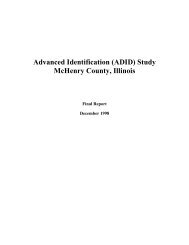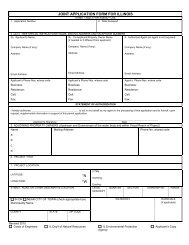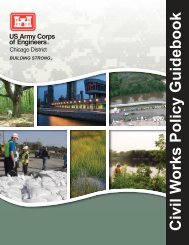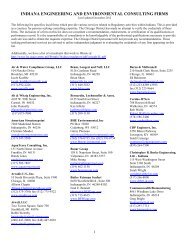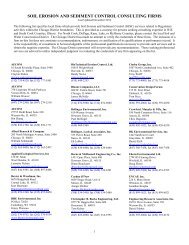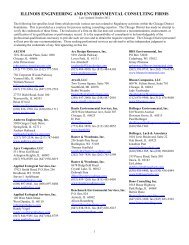Appendix G - Geotechnical Analysis - Chicago District - U.S. Army
Appendix G - Geotechnical Analysis - Chicago District - U.S. Army
Appendix G - Geotechnical Analysis - Chicago District - U.S. Army
Create successful ePaper yourself
Turn your PDF publications into a flip-book with our unique Google optimized e-Paper software.
Figure 3. General Thickness of Overburden in Project Area<br />
11. Due to glacial scouring and alluvial deposition, the <strong>Chicago</strong> area is a lake plain,<br />
surrounded by moraines paralleling former shorelines of glacial Lake <strong>Chicago</strong>. The Des<br />
Plaines River is a primary drainage feature in northeastern Illinois. The river valley<br />
where the river has historically meandered and changed course can be as wide as one<br />
mile in some places. Over the last 200 years, the river has become increasingly<br />
channelized due to urbanization, reducing the Des Plaines River’s opportunity for<br />
meandering.<br />
12. Glacial till, glaciolacuatrine and glaciofluvial deposits are the major materials<br />
deposited on top of the Silurian dolomite bedrock in Lake and Cook Counties. The major<br />
topographic features in these counties reflecting the influence of glacial deposition<br />
(moraines); till plains and sand and gravel outwash plains; a few knob-like hills of sand<br />
and gravel (kames); and the Sag, Fox, and Des Plaines River valleys which were<br />
drainage-ways for glacial melt-waters. Sand and gravel accumulated as valley trains<br />
along these rivers.<br />
7<br />
P:\PRJ-Des Plaines II\TS-DG <strong>Geotechnical</strong>\Feasibility <strong>Appendix</strong>\Des Plaines II Geotech <strong>Appendix</strong> 082713.Doc



